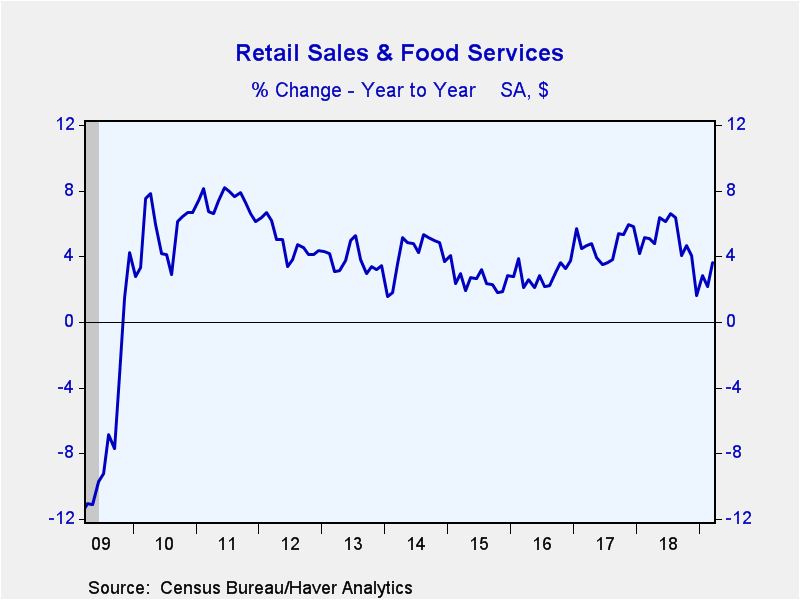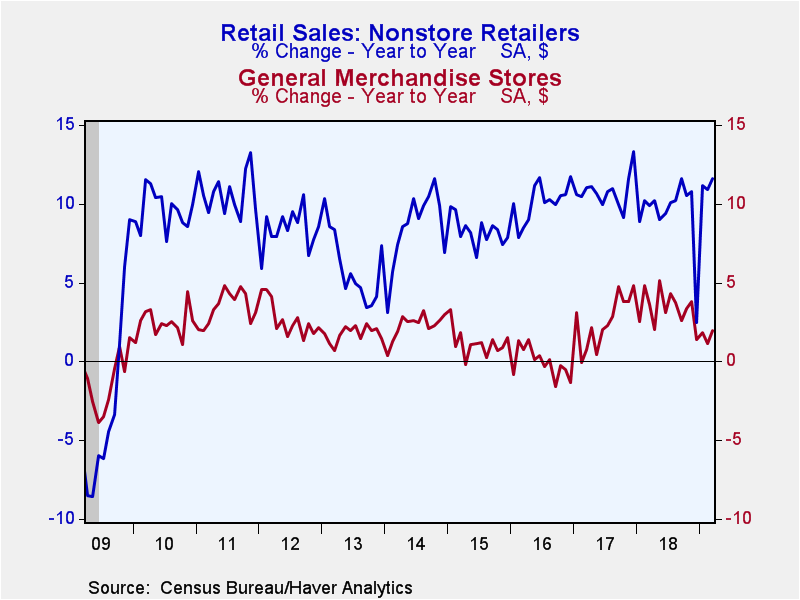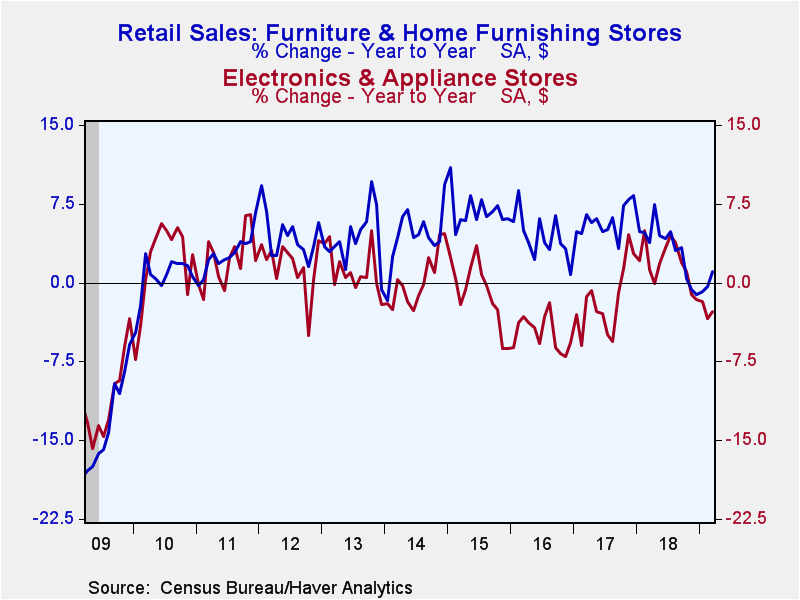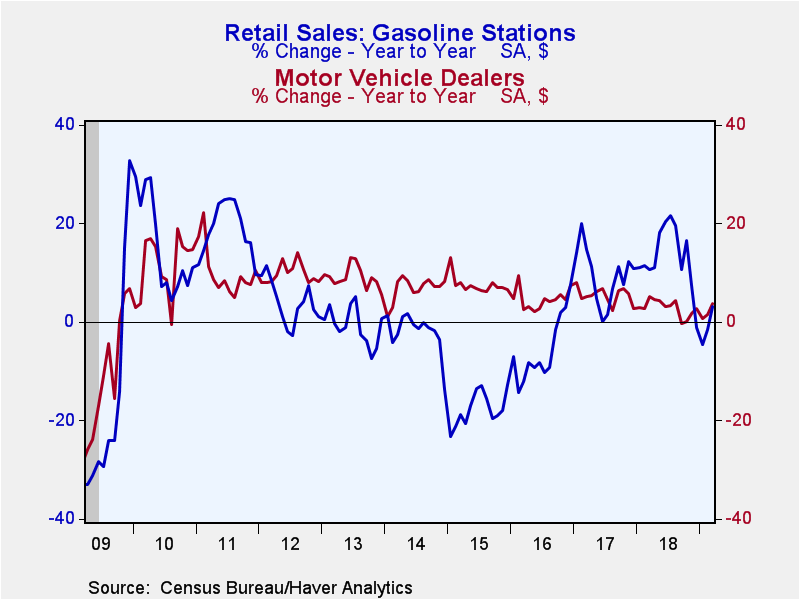 Global| Apr 18 2019
Global| Apr 18 2019U.S. Retail Sales Rebound Is Broad-Based
by:Tom Moeller
|in:Economy in Brief
Summary
Total retail sales increased 1.6% during March following a 0.2% February dip. It was the largest monthly increase since September 2017. The 3.6% y/y sales pace, however, remained down from growth during 2018 and 2017. A 0.9% March [...]
Total retail sales increased 1.6% during March following a 0.2% February dip. It was the largest monthly increase since September 2017. The 3.6% y/y sales pace, however, remained down from growth during 2018 and 2017. A 0.9% March rise had been expected in the Action Economics Forecast Survey.
A 3.1% increase (3.8% y/y) in sales of motor vehicle & parts was part of last months' sales strength after easing 0.1% during February. This compared to unit sales of motor vehicles which increased 5.3% during March. Excluding motor vehicles and parts, retail sales rose 1.2% (3.6% y/y) after slipping 0.2%. A 0.7% rise had been expected.
A measure of the underlying pace of retail spending is nonauto sales growth excluding gasoline and building materials. These sales surged 1.0% (3.7% y/y) during March after a 0.2% decline. These sales also increased 1.5% during January.
Strength in sales was broad-based last month. Clothing store sales rebounded 2.0% (1.5% y/y) following three straight months of sharp decline. Home furnishings store sales increased 1.7% (1.1% y/y) after a 0.8% rise. Sales via the internet strengthened 1.2% (11.6% y/y) for the second consecutive month. Electronics & appliance store sales rose 0.5% (-2.7% y/y) following 1.4% drop. General merchandise store sales gained 0.7% (1.9% y/y) after a 0.3% fall. Sales of building material stores improved 0.3% (3.3% y/y) after a 4.4% shortfall. Weakening by 0.3% (-9.7% y/y) were sales at sporting goods, hobby shops, book & music stores after a 0.3% gain.
Higher prices lifted sales at gasoline service stations by 3.5% (3.1% y/y) for the second consecutive month.
Sales of nondiscretionary items improved last month. Food & beverage store sales rebounded 1.0% (1.8% y/y) after a 1.9% decline. Health & personal care product store sales rose 0.2% (4.4% y/y) following a 0.6% increase.
Restaurant & drinking establishment sales increased 0.8% (4.3% y/y) after a 0.3% gain.
The retail sales data can be found in Haver's USECON database. The Action Economics forecast is in the AS1REPNA database.
| Retail Spending (% chg) | Mar | Feb | Jan | Mar Y/Y | 2018 | 2017 | 2016 |
|---|---|---|---|---|---|---|---|
| Total Retail Sales & Food Services | 1.6 | -0.2 | 0.8 | 3.6 | 4.9 | 4.7 | 2.9 |
| Excluding Autos | 1.2 | -0.2 | 1.4 | 3.6 | 5.5 | 4.7 | 2.5 |
| Retail Sales | 1.7 | -0.3 | 0.8 | 3.5 | 4.7 | 5.0 | 2.5 |
| Motor Vehicle & Parts | 3.1 | -0.1 | -1.8 | 3.8 | 2.7 | 4.9 | 4.3 |
| Retail Less Autos | 1.2 | -0.3 | 1.6 | 3.5 | 5.4 | 5.0 | 2.0 |
| Gasoline Stations | 3.5 | 3.5 | -1.7 | 3.1 | 12.9 | 9.4 | -5.8 |
| Food Service & Drinking Places Sales | 0.8 | 0.3 | 0.4 | 4.3 | 6.1 | 3.1 | 5.2 |
Tom Moeller
AuthorMore in Author Profile »Prior to joining Haver Analytics in 2000, Mr. Moeller worked as the Economist at Chancellor Capital Management from 1985 to 1999. There, he developed comprehensive economic forecasts and interpreted economic data for equity and fixed income portfolio managers. Also at Chancellor, Mr. Moeller worked as an equity analyst and was responsible for researching and rating companies in the economically sensitive automobile and housing industries for investment in Chancellor’s equity portfolio. Prior to joining Chancellor, Mr. Moeller was an Economist at Citibank from 1979 to 1984. He also analyzed pricing behavior in the metals industry for the Council on Wage and Price Stability in Washington, D.C. In 1999, Mr. Moeller received the award for most accurate forecast from the Forecasters' Club of New York. From 1990 to 1992 he was President of the New York Association for Business Economists. Mr. Moeller earned an M.B.A. in Finance from Fordham University, where he graduated in 1987. He holds a Bachelor of Arts in Economics from George Washington University.










